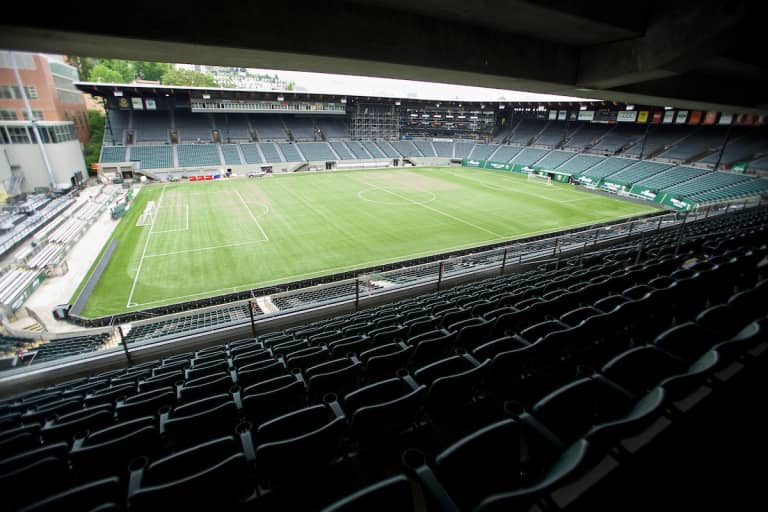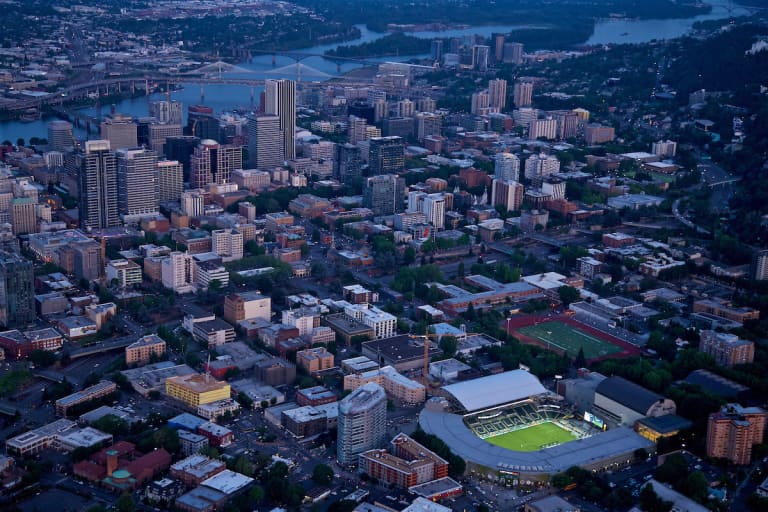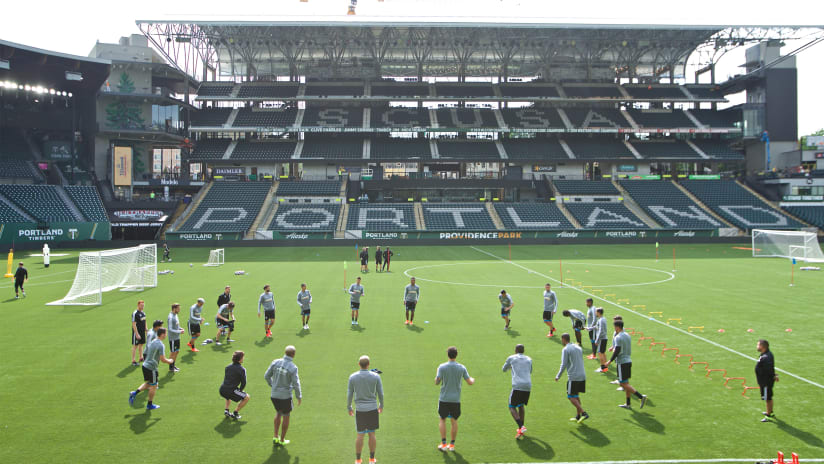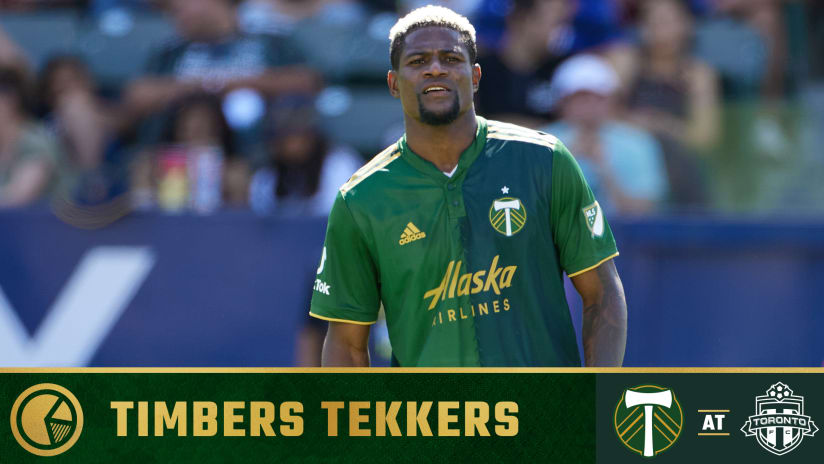PORTLAND, Ore. – The main changes to Providence Park lie overhead as you walk through the venue’s new, east side expansion, one that adds 4,137 seats to the formerly 21,144-capacity stadium. It feels like a different park, now – a full one, with the tiers that extend three levels above reminding you that Goose Hollow’s 93-year-old landmark has caught up to its 21st-century brethren.
You can still see out to the street, though. You’ll hear the MAX pass behind the first level’s new gating, see it from the new windows of Tanner Ridge, above. But on that ground floor, a curated display tracking the evolution of the site remains: from vegetable gardens at the end of the 1800s; to the pipe that was installed in 1916 to protect Tanner Creek from Daniel Lownsdale’s Tannery; to the early century construction of Multnomah Field; to the population booms of mid-1900s Goose Hollow.
As the displays continue behind sections 98 and 99, crafting a timeline that takes us to the present day, the intentions of the ground’s new custodians are made clear. The Portland Timbers and Thorns are responsible for the historic site, helping curate a history that includes its early dog races, mid-1950s ski jumps, an Elvis Presley concert and, perhaps most famously, the mid-1970s arrival of the North American Soccer League. From south to north, you can walk that history, with a commemoration of the moniker “Soccer City USA” marking the chronology’s final stop.
Changes have happened below, too, where a remodeled KeyBank Club gives the long-serving members of Providence Park’s east side a new, more open space to spend their pregame time. The team’s Ring of Honor faces out from the third level, Toyota Terrace, now, extending from the stand’s north side as a list of the club’s accomplishments stretch from the south. New video displays facing the field adorn the top of the Club as well as Tanner Ridge’s face – the new second level – while the shade from the side’s new roof will, during those earlier kickoffs, help the new seats' exposure to the sun.
It’s as you move toward that roof, though, that the east side’s biggest changes come into view. Taking one of the two new elevators at the side’s north end, you reach the second floor of what feels more like a new NBA arena than another soccer park. The polished concrete below includes an emblem of the club's community outreach platform, Stand Together, with its crossed axes. Windowed views of the field, to your right, and Providence Park’s MAX stop, on your left, flow into a corridor of open-air concessions; large television displays at every turn; images of Douglas firs decorating the bathroom bays; and a lounge of leather couches creating a vista toward Lincoln High School. Sound from the field and Goose Hollow’s traffic is pushed out by double-paned glass, creating a vacuum filled by the field’s energy every time a fan opens a door.
The seats at the front of Tanner Ridge may be the best in the house. Still elevated above the Club’s flatter views, sections T4 and T5 get the east side’s new perspective while still being able to see the park’s new features: the scoreboard north of the press box; the new displays near the Multnomah Athletic Club; the places where titles and cups are still honored in the north. From the top of the Tanner Ridge sections, those views are obstructed, but displays hanging high from below the next deck allow those seats to stay connected to sights around the park.

Image: Sam Ortega / Portland Timbers/Thorns FC
Behind, an open area at the center of Tanner Ridge features a full bar and two concession options, as well as space to gather before and after the action starts. New dining spots greet fans at Tanner Ridge's north and south ends, too – a dynamic that’s replicated at the top two levels as well.
The differences at those stops go beyond their heights. In the climb to the third level, the Toyota Terrace, you’re reconnected to the open air, with the sounds from the stairwell that opens to SW 18th Avenue continuing as you enter the stand’s middle corridor. Instead of a lounge looking out toward Lincoln, an open deck shielded by the side’s final level will allow hundreds to enjoy views extending into the city’s southwest hills. Another new elevator shaft is there, from which you see the shortened length and steep climb of the Duracell Deck, above. Sight lines from the last row of the Terrace still allow you to see every seat in the north, west and south sides of the park. At a height slightly above the MAC's famous balcony, every blade of the field is within a sharp-angled view, with the open path to the level’s concession bays giving the second tier a modern stadium's feel.
Around those concessions are images of Timber Joey, on one side, with a four-panel mural honoring the Thorns on the other. A memory of **Christine Sinclair** besting U.S. international Julie Ertz in a challenge gets its own wall, facing north. The message “Welcome to Soccer City USA” hangs above sections ET3 through ET6, with the acronym “SCUSA” spelled out in white seats throughout the stand’s section, two levels above the iconic “PORTLAND” running through the KeyBank Club. Open decks at the north end looking out toward the Pearl District, as well as back toward the field, finish off the level’s floor plan, with the breeze flowing through the open corridor maintaining your attachment to Goose Hollow.
The climb to the top level doesn’t lead to a door. The first view is of the steel roofing, above. Soon, the heightened breeze reminds you of why you made the climb at all. This, the seats looking down on the last version of the park, from which you can see the roofs above the North End, the Sunset Porsche Audi Suites and the west side’s press box, leaves you dreaming about other famous grounds. What is it like at the top of the Nou Camp? The Santiago Bernabéu? Old Trafford, or Signal Iduna Park?

Image: Sam Ortega / Portland Timbers/Thorns FC
Providence Park can never be like those places, but from the high angles at the top of the Duracell Deck, and descending the steep rake of the terrace’s six rows, you lose the feeling of an MLS venue. This is closer to the picture you have at the heights of an Old European ground, where cramped, urban footprints have forced clubs to be creative with their added numbers.
The footprint, here, is the same as below, in large part. Elevator shafts at both ends keep the two stairwells from overcrowding, providing another way to reach the new summit. Concessions in the north, south and middle help define each level’s flow, with one noticeable difference in the central part. At the top level, instead of a bar running lengthwise, parallel to the field against the stand’s eastern well, fans can gaze over a railing to see the downtown skyline that used to be one of the park’s signature parts.
- OLD AND NEW: Park Provisions bring more options, local flavor
- OLD AND NEW: Stadium technology getting a boost with expansion
- OLD AND NEW: Updated west and north sides part of stadium rebirth
Now, however, there are new signatures, ones that help you remember the context cast by the timeline on the first floor. From the fourth level’s south end, there’s a new connection to the West Hills’ arbors that never existed before, with windows of the trademark houses that peek through the wooden skyline giving an iconic part of Portland a new link to its renovated landmark. The entirety of Lincoln’s track is in view, and in the scope of Goose Hollow you can see from its heights, Providence Park’s bond with its surrounding neighborhood is, to the eye, reinforced.
The top deck’s north end, though, may offer a more profound view, one that extends back out into the city, over the Alphabet District, into the Pearl, toward the Willamette and out to Mount Hood. The stadium’s space as a vital part of Goose Hollow has always been evident, but in the miles into the horizon that can be seen from the new summit, a progression from the rest of the city, from its eastern edges and its spine at the river, has been revealed, casting a near century-old landmark as part of its city’s nervous system.
From the river into downtown, across the freeway into the core’s supporting neighborhoods, Providence Park lies at the edge of one world, marking the line where business becomes residential, and work becomes something else. There, in its progress, the venue has mimicked its city’s growth; and now, in its new look, it offers Portland sports a new era.

Image: Craig Mitchelldyer / Portland Timbers/Thorns FC












